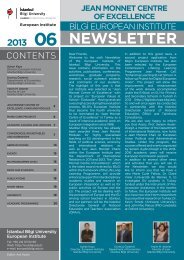WP2 Turkey: Country Report - İstanbul Bilgi Üniversitesi | AB Enstitüsü
WP2 Turkey: Country Report - İstanbul Bilgi Üniversitesi | AB Enstitüsü
WP2 Turkey: Country Report - İstanbul Bilgi Üniversitesi | AB Enstitüsü
Create successful ePaper yourself
Turn your PDF publications into a flip-book with our unique Google optimized e-Paper software.
Social Impact of Emigration and Rural-Urban Migration in Central and Eastern Europe<br />
VT/2010/001<br />
The majority of Kurds speak the Kırmance (Kurmanci) dialect of Kurdish, and a minority<br />
speak Zaza.<br />
Furthermore, <strong>Turkey</strong> has been positioned on the transit route for irregular migrants from<br />
Afghanistan, Bangladesh, Iraq, Iran, and Pakistan since the 1990s (Kirişçi, 2003; İçduygu,<br />
2009). Several different developments in the immediate neighbourhood of <strong>Turkey</strong> such as<br />
the Iranian revolution, political turmoil in the Middle East, end of the Cold War, the Gulf War,<br />
and <strong>Turkey</strong>’s geographical location as a transit space between the West and the rest of the<br />
world turned <strong>Turkey</strong> into a de facto country of first asylum. It should be noted that <strong>Turkey</strong><br />
grants refugee status only to European asylum seekers. It has until recently ranked in the top<br />
three countries globally for resettlement of non-European refugees, with the main countries<br />
of destination for resettlement being the United States, Canada, and Australia (IOM, 2008:<br />
31). Migration issues in <strong>Turkey</strong> are shaped by its efforts to become a member of the<br />
European Union, creating pressures on the revision of its immigration and asylum policies<br />
(Kirişçi, 2009). The efforts regarding the signing of the Readmission Agreement with the<br />
European Commission have come to the very last stage. 1<br />
The return migration of the 1990s and 2000s is quite different from that of the 1970s and<br />
1980s. The early returns were either the outcome of cyclical labour migration or of the<br />
assisted remigration programs as in 1984. Today, return migration has become a constant<br />
process of mobility for those transmigrants between the country of residence and the country<br />
of origin. Many Turkish emigrants who had previously settled in various European countries<br />
are returning to <strong>Turkey</strong>, but not all of them permanently. For some of them, we cannot even<br />
use the term “return” as they were born and raised in their countries of residence. Today,<br />
many of the first generation migrants who migrated in the 1960s and 1970s and later<br />
became retired have started living six months in <strong>Turkey</strong> and six months in Europe.<br />
<strong>Turkey</strong>-EU relations have recently become very dynamic. Since the Association Agreement<br />
("Ankara Agreement") was signed between the Community and <strong>Turkey</strong> in 1963 and the<br />
protocol added in 1970, the two sides are getting engaged in strengthening trade and<br />
economic relations and the establishment of a customs union. Another objective set forth in<br />
the Ankara Agreement was the free movement of workers. For socio-economic reasons<br />
however, it has not been possible to achieve this according to the timetable set. The EU is<br />
going through a political, social and economic crisis while Turkish economy is booming<br />
together with the fact that it has experienced the recent global financial crisis rather smoothly<br />
in comparison to European countries. With a large and dynamic population (for her key<br />
demographic indicators see Table 1), the country’s economy grew an average of 6.0% per<br />
year from 2002 through 2007 - one of the highest sustained rates of growth in the world;<br />
declined during the 2008-2009 crisis but recovered quickly in 2010 (with a growth rate of<br />
6.8%); and the per capita income (adjusted by purchasing power parity) is 10.350 Euro<br />
(2009 figures). 2<br />
2. Main Emigration and Internal Migration Trends and Patterns<br />
Starting from the second half of the 20 th century <strong>Turkey</strong> was faced with a rapid process of<br />
both international and national migration. It may be said that within this process we may<br />
clearly see in operation the classical pull and push factors of sociological literature. Almost all<br />
factors such as industrialization and mechanization in agriculture as well as qualitative and<br />
quantitative superiority of various services like health and education in urban areas have<br />
always played an important role in migration towards cities in <strong>Turkey</strong>. Since the 1960s and<br />
1970s various studies have focused on internal migration. 3 Those push and pull factors at<br />
1<br />
Council conclusions on EU-<strong>Turkey</strong> Readmission Agreement and related issues,<br />
http://www.consilium.europa.eu/uedocs/cms_data/docs/pressdata/en/jha/119501.pdf.<br />
2<br />
Unless otherwise stated, all data are from the official statistical institute of <strong>Turkey</strong>, TÜİK<br />
(www.tuik.gov.tr).<br />
3<br />
Some of the main studies on internal migration in <strong>Turkey</strong> may be listed as follows: Adaman and<br />
Ardıç (2008), Gedik (1966), Yasa (1966), Geray (1962), Hart (1969), Karpat (1969, 1983), Kıray<br />
(1972, 2000), Kıray and Hinderick (1970), Sewell (1964), Şenyapılı (1996), Tekeli (1974, 1990), and<br />
Tekeli and Erder (1978).<br />
Final <strong>Country</strong> <strong>Report</strong> <strong>Turkey</strong> 4



